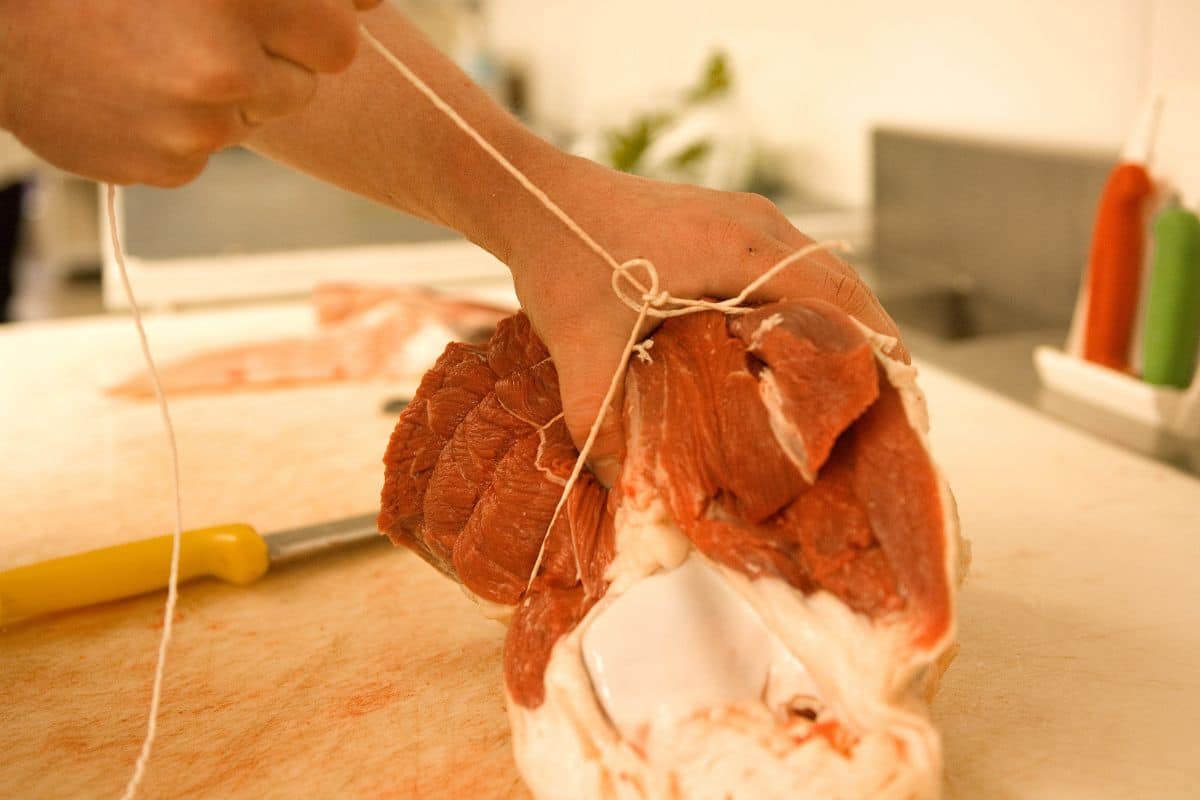When it comes to preparing meat, poultry, and fish, the most common tool at your disposal is butcher’s twine.

This is usually colored, often elasticated twine that allows you to hold the joint of meat in place – either rolled tightly with ingredients stuffed inside, or, in the case of chicken and turkeys, tied up neat and together ready for cooking.
However, should you not have butcher’s twine at your disposal when it comes time for cooking to begin, there are other alternatives you can use to achieve the desired result in a safe and effective manner – including dental floss, toothpicks, aluminum foil, and much more.
What Are The Uses For Butcher’s Twine?
There are many reasons why butcher’s twine is used within cooking and preparing meat, poultry, and fish.
For Neatness
Firstly, it can be a great way to ensure neatness while cooking – something that is especially useful if you work in the restaurant industry, or you regularly cook impressive meals.
This can be seen when people cook poultry, and in fact when you buy whole chickens and turkeys from your local butcher shop, their ankles are usually tied together to create a more neat, pleasant looking carcass.
This is also because the thighs and legs of birds are often heavy and meaty, which means that they will not stay in place when not fastened together.
For Stuffing
If you are preparing meat or poultry that requires other ingredients to be stuffed within it – such as garlic butter and sage for example – you will need to wrap the meat around the other products to ensure that they stay together during cooking, and that the end result is achieved.
The 8 Best Alternatives For Butcher’s Twine
Now that we know a little more about butcher’s twine, and its many uses within cooking and food preparation, it is now time to look at some other alternatives that you can use if you either run out, or find yourself running low on butcher’s twine.
So, without further ado, let’s get started!
1. Toothpicks
The first thing you could use to secure your meat ready for cooking is toothpicks. These come in all shapes and sizes, but ideally you want to find the longest ones you can, and they need to be unflavored and unscented.
This will allow you to secure the meat in place during cooking, after which the toothpicks can be removed and eating can commence.
2. Aluminum Foil
Another common kitchen accessory is aluminum foil, and this can be really useful for holding meat in place during cooking.
Of course, the only downside with this option is that it insulates the meat to a certain degree, which might mean that your cooking time increases somewhat, or you need to use a higher cooking temperature.
However, this can be good for beef and pork – especially that which you would like to be tender and moist upon eating.
3. Dental Floss
You could also use dental floss to tie up and secure your meat and poultry during cooking. This serves the same general purpose as butcher’s twine, and can be a cheap and easy way to achieve the same end.
Of course, you need to make sure that it is clean, kept away from germs, and that it does not have any flavors or smells that might taint the food during cooking.
4. Silicone Cooking Bands
For something a little more high tech, you could also use silicone cooking bands. These are less commonly acquired than the other items on this list, and as such are only appropriate if you have the time, money, and incentive to go out and find them.
However, they can be really effective, and the best thing is that are usually reusable – meaning you can avoid wastage, and reuse your cooking bands time and time again for years to come.
5. Baking Paper
You could also wrap your meat in baking paper – another common household product, and one that can be perfectly effective at keeping the meat secure and together during cooking.
The benefit of this product is that it allows the heat to permeate more than foil, meaning that your meat will not sweat as much, and will require less heat and time to cook properly.
6. Wooden Skewers
You could also use wooden skewers. These are most commonly used when making kebabs, shawarma, and other Middle Eastern cuisine, and have the benefit of being much longer than toothpicks.
This means that, if you have large pieces of meat that need to be held together, then you can use this to achieve that purpose.
They are also widely available in most supermarkets, and are generally quite cheap, meaning you do not have to worry about breaking the bank and wasting your money every time you wish to cook your favorite meat dish.
7. Green Onions
Alternatively, why not use something naturally long, and string-like to secure your meat. One example is green onions, naturally long, bendy, and firm vegetables that are also flavorful and aromatic.
This not only means that the meat will stay secure, but that the flavor of the onions will infuse with the meat, creating a tasty dish for you all to heartily enjoy.
8. Regular String
Last on our list, but by no means least, you could also just use regular string.
This can be great for adding a little rustic charm to your dish, and effectively does the same job as butcher’s twine – albeit without the stretchy, elasticated composition that you get with butcher’s twine.
This means that you will have to wrap it tighter around the meat, due to the fact that it is not elasticated, and therefore will not just hold in place by itself.
You should also try to make sure that the string is tightly wound, and not prone to molting, as this could cause fibers to wind up in the food and ruin the experience for everyone.
Popular Recipes To Try
Now that we know the best substitutes for butcher’s twine, it is now time for us to look at some recipes that might require twine during preparation and cooking.
Roast Chicken
Roast chicken (or turkey) is one main example of when butcher’s twine comes in handy. Generally speaking, butcher’s twine keeps the bird together during cooking, and means that it does not fall apart as easily during this process.
When the legs are not tied, and are stretched open, it can become easier for the legs to separate at the hips – meaning that you have a messier looking finished product.
Rolled Beef Tenderloin
This is another recipe where butcher’s twine might come in handy.
Once you have added your stuffing to the inside of the beef, and you have rolled the beef into a roll, you will then need to tie (or otherwise secure) the meat with something in order for it to cook properly, and not spring open during cooking.
Toothpicks can be useful for this, as can foil and other alternatives mentioned on this list.
Final Thoughts
And there we have it, everything you need to know about butcher’s twine, and the 5 best alternatives for cooking and tying meat during preparation.
It is certainly true that butcher’s twine has many uses within cooking. However, if you do not have any to hand, there are luckily numerous alternatives that you can use instead to help you get the job done.
So if you are running low on butcher’s twine, and are in need of replacements, then be sure to give these options a try. Something tells me you won’t be disappointed!
Frequently Asked Questions
Now that we know a little more about butcher’s twine, and the various alternatives that you have at your disposal, it is now time for us to answer some frequently asked questions that you might be interested in.
You can purchase butcher’s twine from most large supermarkets. However, if you still have no luck, you can easily purchase them from Amazon.com, and similar websites.
For general cooking at home, butcher’s twine is seldom necessary. However, as this article shows, there are opportunities for cooking and meat preparation where twine (and various alternatives) come in handy.











